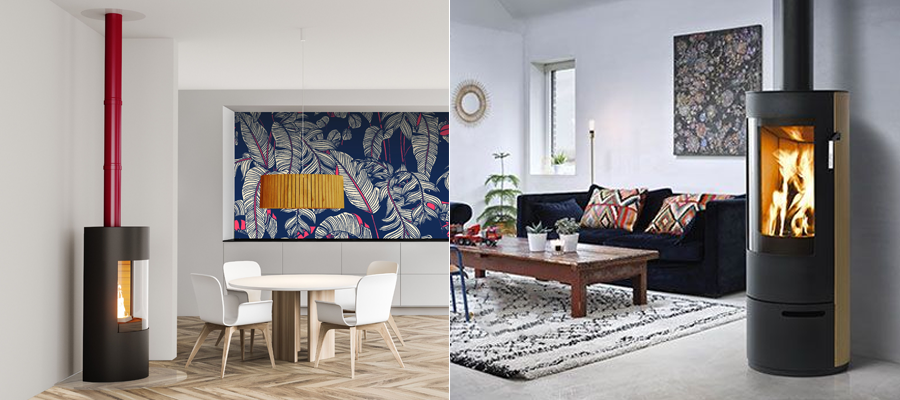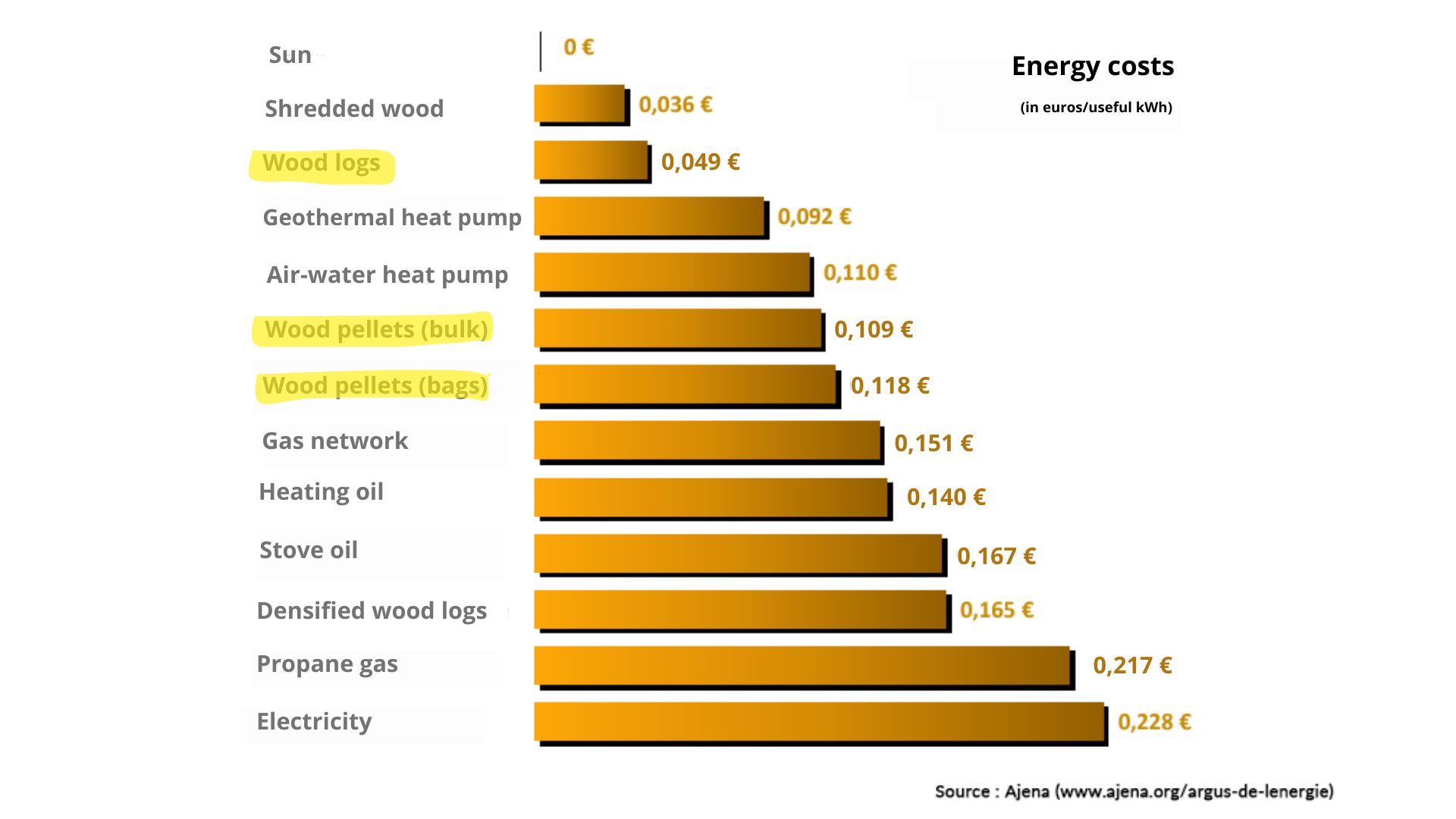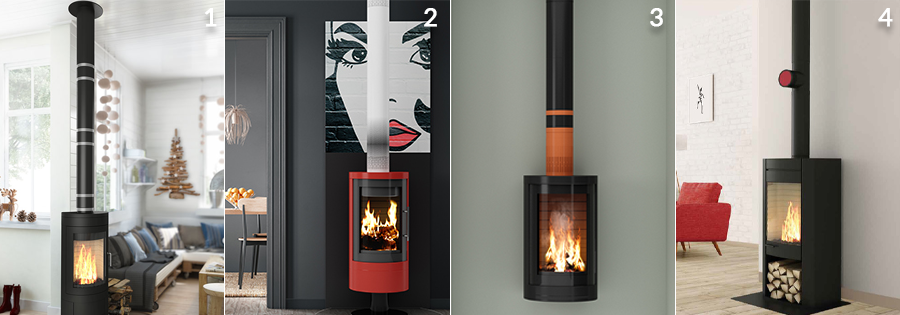Pellet stove or log stove, which should you choose?
You're planning to install an independent wood-burning appliance as part of a new house, extension or renovation. But you're still torn between logs and pellets. To help you make the choice that's best suited to your needs and desires, we've compared them on a number of points.

Pellet stove or wood stove, which offers the best performance?
In terms of performance, the pellet stove has a slight advantage, even though the log-burning stove is a serious competitor. Why are pellets more efficient? The fuel supply to the fireplace and the supply of combustion air are regulated automatically to ensure that combustion is as perfect and regular as possible.
For pellet stoves, several manufacturers are currently advertising efficiencies of up to 96% (according to a panel of Flamme Verte-labelled appliances that may be updated).
Because of the way it works and the fact that it is manually fed, the average output of a log-burning stove is slightly lower (reloading and door openings inevitably cause variations). Nevertheless, it remains extremely attractive, with energy yields of up to 90%.
And don't forget that when it comes to the performance of a log-burning stove, the choice of quality wood fuel is of paramount importance. We'll talk more about this below.
- Pellet stove ⭐⭐⭐
- Wood stove ⭐⭐
Is there a difference in terms of environmental impact?
In both cases, you get a 100% natural product, which is no mean feat! Yes, if you've forgotten or don't know yet, pellets come from the recycling of compacted wood by-products (sawdust and wood shavings). No trees are cut down to produce them.
High-performance wood logs are debarked, split and dried to provide optimum calorific value.
Both of these fuels are harvested and processed in France, usually within a radius of the marketing sites to avoid transport that is too costly from both an economic and environmental point of view.
Whether pellets or logs, wood is considered a carbon-neutral renewable energy source when its entire life cycle is taken into account, since the CO2 released during combustion is that which the tree absorbed during its growth.
Be careful, the quality of the combustion of wood logs, and therefore their environmental performance, depends largely on their quality! Be vigilant about the products you use by checking the labelling.
The same goes for pellets, even if their production has become standardised, opt for DIN+/NF-certified products for guaranteed performance and comfort.
- Pellet stove ⭐⭐⭐
- Wood stove ⭐⭐⭐
-
Which appliance is easiest to use?
Simplicity of use is probably one of the strong points of the pellet stove. Easy to load, easy to light, programmable, and increasingly controllable from a distance, pellet stoves stand out in this respect.
But automation also means a motor and a power supply... things that a wood-burning stove doesn't need! If you're not keen on electronics and technology, if you prefer the simplicity and authenticity of wood, and if manual loading is part of the charm of a wood fire, the log-burning stove is for you. Two schools, two possible choices.
If you opt for a wood-burning stove, choose ready-to-use log fuel that has already been dried (≤ 20% moisture content), graded and debarked, and packaged for easy storage to simplify the regular supply of fuel to the appliance.
- Pellet stove ⭐⭐⭐
- Wood stove ⭐⭐⭐
-
Which offers the longest heating time?
This is where pellet stoves come into their own, with a range of up to 24 hours (or even more) without having to recharge the tank (although this does depend on the model).
Wood-burning stoves, on the other hand, will need to be refuelled more regularly to maintain a constant, long-lasting heating temperature.
Now, it all depends on your needs and your heating habits. If you want to use it as a back-up, a wood-burning stove will do the trick.
- Pellet stove ⭐⭐⭐
- Wood stove ⭐
Which one is compatible with AIRWOOD? (warm air distribution system)
Good news! Both log and pellet appliances are compatible with the AIRWOOD Confort+ warm air recovery and distribution system, for new build and renovation projects. The appliance you choose can therefore be complemented by AIRWOOD, and you can benefit from wood heat in the rest of the house. By adding the BOOSTY option, this system will even become your home's main heating system. Here's how AIRWOOD works:
Our advice: if you are planning to install an AIRWOOD Confort+ system at a later date, choose Cheminées Poujoulat flues (THERMINOX or PGI) from the start of the project, as they are the only flues compatible with warm air distribution systems.
- Pellet stove ⭐⭐⭐
- Wood stove ⭐⭐⭐
Pellets or logs, which fuel is more competitive?
Generally speaking, and even if the successive crises of recent years have turned the sector upside down, wood energy remains one of the cheapest energies on the market, as confirmed by the Argus des énergies published by the Ajena association in November 2023*:
* The data mentioned in this graph is related to the French market and may vary based on the European geographical region

Between wood logs and wood pellets, wood pellets are more expensive because the production process is more complex.
Variations can also be observed depending on the region and/or during certain periods of high and low demand.
- Pellet stove ⭐⭐
- Wood stove ⭐⭐⭐
-
Which is the most expensive?
If you take into account the complete equipment (independent appliance + flue) + installation, the total cost for a pellet stove is higher, because the appliance incorporates electronics, motors and sometimes even connectivity.
Wood-burning stoves, on the other hand, are simpler in design and less expensive (depending on the model and brand).
- Pellet stove ⭐⭐
- Wood stove ⭐⭐⭐
Flue maintenance, cleaning and sweeping
Wood-burning appliances require daily cleaning during the heating period. In both cases, the ash from burning wood has to be removed, and the glass has to be cleaned when it is slightly blackened, etc.
Logically, a pellet stove produces less ash, but the crucible must be cleaned after each use to avoid clogging the holes and creating clinker.
Chimney sweeping is compulsory in both cases. At least once every 12 months, but for consumption in excess of 6 MAB of wood logs (MAB, for cubic metres of wood) or 2.5 tonnes of wood pellets, the regulations that came into force on 1 October 2023 recommend two chimney sweeps a year (including one during the heating period).
As for maintenance costs, these are slightly higher for pellet stoves, given the checks that need to be carried out on the electronic/electrical/engine system.
In both cases, maintenance and chimney sweeping should be carried out by qualified professionals.
- Pellet stove ⭐⭐
- Wood stove ⭐⭐⭐
Which has the longest lifespan?
It's impossible to say for sure. The key to the longevity of these heaters lies in a number of factors:
- the quality of the equipment
- proper installation
- use in accordance with the manufacturer's recommendations
- proper cleaning
- checking and maintaining the entire system (including sweeping the flue) in accordance with current regulations.
Once this has been done, and apart from a few exceptions, the equipment will operate perfectly for many years to come.
Note that pellet stoves, like any appliance with built-in electronics, can be more prone to breakdowns.
- Pellet stove ⭐⭐
- Wood stove ⭐⭐⭐
What about customising the installation?
There's no need to go back over the styles and designs offered by appliance manufacturers here, as the choice seems almost limitless: traditional, contemporary, classic, retro, modern, raw, sober, original, coloured, monochrome, stone, steel, panoramic, cubic, round, suspended, adjustable, compact, wide, high, etc. (we've selected a few inspiring installations here).
Instead, let's focus on the range of options available for personalising your installation and taking care with the finish. And on this point, the wood-burning stove offers more.
While coloured flues and the addition of painted collars(1) are available for pellet and wood-burning stoves, DESIGN'UP takes things a step further by also offering :
- ventilated cladding(2) to be fitted around the flue (discover the DESIGN'UP range)
- an element to create an aesthetic connection between the THERMINOX (3) flue and the spigot of the wood stove. (discover the DÉCO'START Adjustable range)
- a new-generation draught regulator(4) that is both stylish and energy-efficient... (discover the REGUL'ART range)

- Pellet stove ⭐⭐
- Wood stove ⭐⭐⭐
In terms of comfort and charm, the winner is...
Let's end the comparison with a criterion of charm and conviviality, and this point is awarded to the wood-burning stove, with its generous flame, its crackling sounds and the serenity it provides... Synonymous with comfort, the wood-burning stove acts like a magnet around which you naturally want to gather, read and relax. An authentic atmosphere guaranteed.
When it comes to comfort, others will prefer the regularity of a pellet stove... It's up to you, there's something for everyone.
- Pellet stove ⭐
- Wood stove ⭐⭐⭐
So, have you made your choice?
It's a pretty even match, isn't it? So if this wood stove VS pellet stove comparison doesn't help you make up your mind, here are a few more tips:
- First, be guided by how you want to use your stove: when, how and how often do you plan to use it?
- Next, assess your storage capacity and your enthusiasm for recharging (or not) the appliance: are you able to have wood/pellets delivered and stored at home?
- If you're replacing an old appliance: what do you like, what's missing, or what wouldn't you like in your new appliance?
Don't hesitate to ask an installer for advice. Their technical expertise, feedback and knowledge of solutions will help you to assess your needs and come up with a solution that's right for you.










